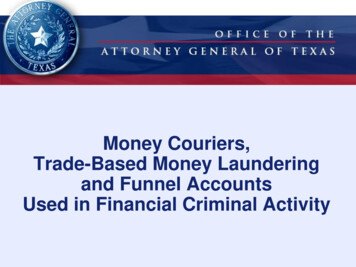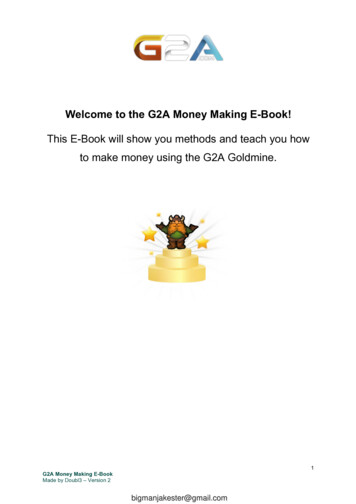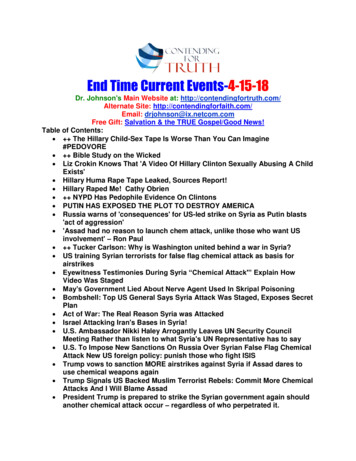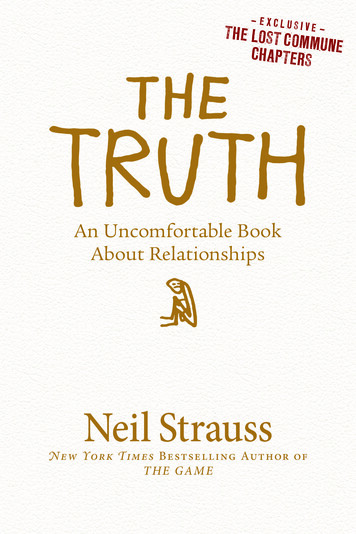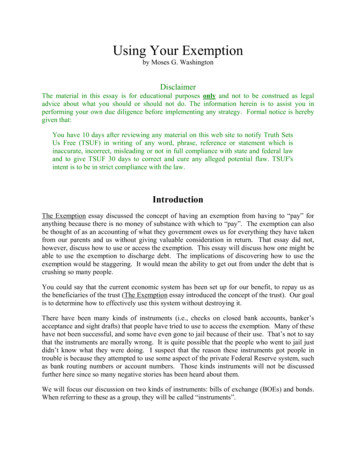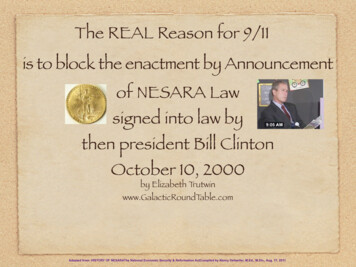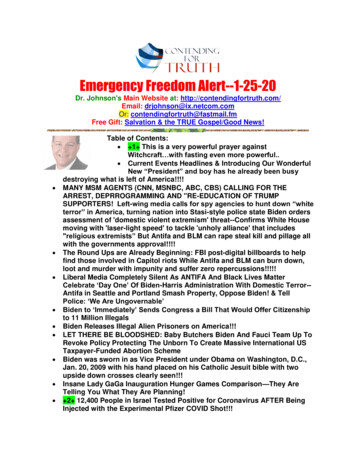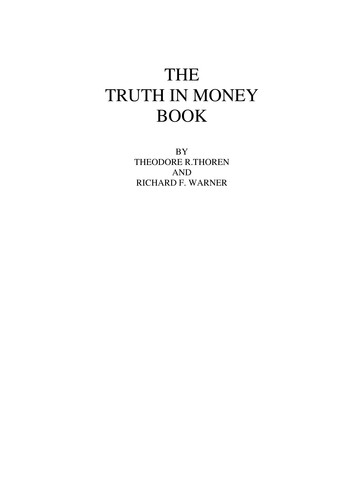
Transcription
THETRUTH IN MONEYBOOKBYTHEODORE R.THORENANDRICHARD F. WARNER
"The privilege of creating and issuing money is not only the supremeprerogative of government, but it is the government's greatest creativeopportunity."Abraham LincolnWhy has the United States strayed from Lincoln's wisdom and allowed a nongovernment body to assume the power to create money?Why are there so many theories, half-truths and crazy notions about the causeof inflation?Why can't experts agree on its cause?Why does President after President request studies on inflation and still pricescontinue to skyrocket?Why is your money becoming worth less faster while the experts debate andthe government does nothing?If you want to know the answers you need to read this book.The Truth in Money Book is based on facts. These facts are shocking but leaddirectly to the solution of our money problem. This solution has been hiddenby ignorance of a simple mathematical principal.Intriguing? Yes! The authors' discovery of the gross errors in the moneysystem were made and confirmed after years of careful research. The scientificunderstanding of money represents a phenomenal breakthrough. This is themost important book on money you will ever read.
DedicationThis textbook is dedicated to Peter Cook. His 40 years of researchand analysis of fractional reserve deposit expansion money systems,together with the objective reports of his findings and his discovery ofMonetary Science, inspired the authors to write this book.We are indebted to Peter Cook for his unselfishness in making hislibrary available to us and for his infinite patience as a teacher of thetruths that are vital to monetary justice and the survival of freeenterprise.II
Table of contentsChapter 1: Asking why was the first step1Chapter 2: Learning the facts was the second step44Chapter 3: Finding the solution104Chapter 4: How to implement the solution and so bring debt-free money into circulation 124Appendix 1: Money supplyAppendix 2: Sample computation of mortgage repayments152153Appendix 3: Coal prices 1900-1979155Appendix 4: A mathematical analysis of the Consumer Price IndexAppendix 5: An illustration of the power of compound interest156159Appendix 6: The prime interest rate161Appendix 7: Compound interest and the 'Rule of 72'162Appendix 8: The Twelfth Century's debt-free money system164Appendix 9: Is the Federal Reserve Bank of Cleveland a private corporation. 166Bibliography167
ForewordFrom the beginning of civilization, monetary instability haspersisted as the predominating cause of human want and woe.This booklet examines the problem of monetary instability usingsimply inductive reasoning - the scientific method of lookingfrom effect back to cause.This study of the cause of monetary instability has led theauthors down a revolutionary path where conventional economicthought had to be overturned to allow simple truths to operate.The solution to our monetary troubles lies not in some complexeconomic formula but in the application of honesty and commonsense to finance. This booklet describes how it can be done, andwhy the effect will be stability and prosperity for all mankind.An impossible task? No, not at all. Let's look at the problemthrough the eyes of a young friend of ours who asked us one day,'Why is it that prices keep going up?' Here is our answer.The AuthorsIV
How it all came about"Prices keep going up-up-up," Ed complained to me. "Joanslittle shoes cost more today than my own number twelves did fiveyears ago. And now I need a new car. My 1976 Chevy is all rustedout. Do you know that the price tag on a Chevrolet is more than itwas on a small Cadillac ten years ago? Why is this, John? Is mostof it in the cost of labor?"Ed didn't give me time to answer. He continued, "I'm workingat an extra night time job too. We're not extravagant, but I canhardly make enough to pay my bills. A pay raise doesn't solve myproblem for very long. I need a raise every six months just tokeep even with the increased cost of everything. And now they'veraised my real estate taxes 30% out there in Maple County!There's something seriously wrong, John, but I simply can't figureout what it is! Can you?""Ed," I said, "Have you ever considered."Ed broke in impatiently, "I read the newspapers but they are ofno help! Sometimes I think they are more confused than I am. I'mnot lazy. I'm not greedy. We are good people trying to make agood honest living. Why are we failing at it?"I had never seen Ed in such a serious mood as he went on, "I'mthinking that there's something 'fishy' going on in this country.You've been around a lot longer than I have. If you know what'swrong I wish you'd tell me, then maybe I could do something toprotect myself and my family."Ed looked searchingly at me and I thought to myself, whereshall I begin to answer his questions? These were the very samequestions I had asked myself five years ago. A short answerwouldn't satisfy him since I knew how long it had taken me todiscover the true but amazing reason forv
inflation. I hadn't believed the true reason myself at first. Wouldhe?Finally I said, "I know your feelings of frustration. I've beenthrough that stage myself. Being semi-retired now I have takenthe time to study this problem in depth for several years. If youand Martha would come over to our home some evening - bring afew friends if you wish - I'll explain in simple language, by meansof some charts, the precise reason why all of us have seriousmoney problems today."Ed seemed eager to accept, saying "I'd love to come if it willhelp me to solve this problem."And so he and Martha and their good friends Earl and Nancydid come over, and this is what I told them.VI
CHAPTER ONETHE FIRST EVENING WITH OUR YOUNG FRIENDSAsking why was the first step"I became interested in studying inflation when I simply askedmyself why it seemed to be that intelligent people could suffer sofrom money troubles which were not of their own making."In 1974 a group of my friends who are businessmen weredrawn together, one by one, as a consequence of the studies eachhad begun independently. They wanted to understand why it wasthat inflation was continuing and in fact accelerating in spite ofthe reported efforts of politicians and economists to stop it."The group met informally about twice a month to exchangeideas, data and reading references. Perhaps the most importantbenefit of those exchanges was the challenge to keep our studiesand thinking strictly on-target namely, to discover precisely thefundamental cause of inflation!"We formed a special study group which now consists of fourprofessional engineers and the president of an advertising,marketing and public relations firm. Each one of us has had atleast twenty years of experience in big business, in responsiblepositions. Our stock-in-trade is the ability to solve problems,engineering problems, accounting problems, financial problems,organization problems."It was natural for us to use the scientific method in our effortsto understand the cause of inflation. We have adhered rigorouslyto the objective of discovering the precise truth about what hasbeen happening economically1
to the people of the United States in recent years, in fact, fordecades!"The results of our concentrated diagnosis of inflation can besummarized in one simple sentence:INFLATION IS CAUSED BY GROSS ERRORS IN THEDESIGN OF OUR MONETARY SYSTEM"Okay that's obvious," Ed said, "but what are they?""Well, very simply, the problem lies in the so-called FederalReserve System which is neither a Federal, that is a governmentagency, nor is it a Reserve of real money!"The gross errors in the monetary system are inherent, that is,they were designed into the system; whether by accident or intentis not relevant at this point."We choose to call these gross errors 'design errors' becausethey can be corrected by a change in the 'system design.' If thethermostat in your home heating system continued to activate thefurnace for more heat when the temperature in the living room is100 F., you would take steps to correct the heating system,because there is either a design error or a system malfunction!"In the Federal Reserve System the overheating or inflation iscaused by design errors, which we will identify, and which haveexisted in the system since the Federal Reserve Act was approvedby the Congress on December 23rd 1913. The United States isnow reaping the cumulative effect of that faulty design. On theother hand a properly designed monetary system is stable -- thatis, self-correcting."The design errors in the Federal Reserve System are subtle butunmistakably identifiable and correctable by a simple act ofCongress."Earl had been sitting quietly attentive up to this point2
but now he broke in, "Is it premature to ask you to name iust oneof those 'design errors'?""This is just the right place to name the most important designerror," I replied, "it is this: most of our money and credit comesinto existence as debt which must ultimately be repaid withinterest to the private Federal Reserve and commercial banks.1Thomas Jefferson had the key to the solution 200 years ago, andhe expressed it this way:If the American People ever allow thebanks to control the issuance of theircurrency, first by inflation and then bydeflation, the banks and corporations thatwill grow up around them will deprivethe people of all property until theirchildren will wake up homeless on thecontinent their fathers occupied. Theissuing power of money should be takenfrom the banks and restored to Congressand the people to whom it belongs, Isincerely believe the banking institutionshaving the issuing power of money aremore dangerous to liberty than standingarmies.2THOMAS JEFFERSON"The subject of money is disposed of by the United StatesConstitution with extreme brevity:Article 1, Section 8, Clause 5: The Congress shall have thepower.to coin Money (and) regulate the value thereof.'"The framers of the Constitution understood the importance ofdelegating this Power to the Congress. Listen to3
Benjamin Franklin on 'Prime Cause of Revolutionary War'The refusal of King George to allow thecolonies to operate on an honest, colonialmoney system, which freed the ordinaryman from the clutches of themanipulators, was probably the primecause of the Revolution.If you do not exclude them from theseUnited States, in this Constitution, in lessthan 200 years our descendants will beworking in the fields to furnish themsubstance while they will be in thecounting houses rubbing their hands.I warn you gentlemen, if you do notexclude them (from Government) for alltime, your children will curse you in yourgraves.3BENJAMIN FRANKLIN"These are strong words. Franklin's 200-year deadline has nowpassed. What we will be talking about in our discussions oninflation will help us to discover whether he was right or not.Have the 'manipulators' been excluded? Are the American peopleworking for their creditors?"In more modern times, Abraham Lincoln was the presidentwho most clearly understood the importance of debt-freegovernment financing and the imperative necessity for thegovernment to spend money into circulation rather than toborrow it into circulation."4
The Government should create, issue, andcirculate all the currency and credit needed tosatisfy the spending power of the Governmentand the buying power of consumers.The privilege of creating and issuing money isnot only the supreme prerogative of Government, hut it is the Government's greatest creativeopportunity.By the adoption of these principles, the longfelt want for a uniform medium will be satisfied.The taxpayers will be saved immense sums ofinterest. The financing of all public enterprises, the maintenanceof stable government and ordered progress, and the conduct of theTreasury will become matters of practical administration. Moneywill cease to be master and become the servant of humanity.4ABRAHAM LINCOLN"These three men said that there is an important relationshipbetween an individual's freedom and the money in his pocket."But even they weren't saying anything that is particularly new.In Proverbs we read that 'The borrower is servant to the lender'.It's a simple truth. I'm sure all of us in this room have hadexperiences when our plans and activities have been restricted bysome financial responsibility to a lender — maybe a relative or acredit card company or a savings and loan company. When theseobligations become greater than our income we're in serioustrouble and all of our activities become limited because of ourdebts."5
"I know one organization that doesn't ever seem threatened byoverspending and debt: that's the government," Nancy said,"When it wants to spend more money it just votes for a biggerfederal debt. I would love to be able to manage my household bythat kind of rule!""I'm glad you've mentioned the federal debt. It really is aserious problem," I said, "do you suppose there could be someconnection between the federal debt and inflation? Let's take alook at the growth in the federal debt since the First Congressconvened in 1789 as shown in Figure 1 and then maybe we'll beable to see if it has any effect on our own finances."5"In September 1979 the debt was 834 billion and risingsteeply. In 1836 the debt was zero. This was during AndrewJackson's administration. The first major increase to 25 billionwas in 1916-1919 (World War I). Then from 1940 to 1946 (duringWorld War II) the debt jumped to 269 billion.6
It has been rising steeply ever since, even in time of 'peace'."People sometimes ask, 'Why worry about the federal debt? Weowe it to ourselves, don't we?'"The truth is we owe it to the holders of government bondsamong whom individual citizens hold only about 10% ( 81billion). We owe some 101 billion to the so-called Federal Reservebanks, which you will be interested to know, are just as private asthe commercial banks which hold about 95 billion worth.6"As shown in Figure 1, this
Appendix 8: The Twelfth Century's debt-free money system 164 Appendix 9: Is the Federal Reserve Bank of Cleveland a private corporation. 166 Bibliography 167. Foreword From the beginning of civilization, monetary instability has persisted as the predominating cause of human want and woe. This booklet examines the problem of monetary instability using simply inductive reasoning - the scientific .

